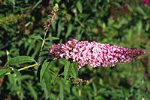 |
This is a small family from tropical and subtropical areas of America, Africa and Asia. A few species and hybrids of Buddleja are occasionally naturalised in southern Australia, along roadsides or in old gardens.
Characteristic features of the family Buddlejaceae in Australia include: - soft-wooded shubs with opposite, simple leaves with stellate hairs
- flowers small but showy, in terminal, more or less dense thyrses (an elongate axis bearing lateral cymes)
- corolla tubular, 4-lobed, slightly zygomorphic, yellow, orange, white, pink or purple
- ovary superior, developing into a 2-valved capsule
Description
Evergreen or semi-deciduous shrubs. Internal secretions not obvious.
Plants glabrous or with dendritic, stellate, clavate, capitate or vesicular
glandular or non-glandular, unicellular hairs. Leaves opposite, petiolate.
Stipules present, interpetiolar; scale-like or membranous or green and
leafy; persistent. Lamina simple, symmetric, lanceolate, ovate, elliptic,
oblong or spathulate; base cuneate, rounded, cordate or lobed or auriculate;
margins entire, crenate, dentate or serrate or sinuate, ±flat;
venation pinnate, with the midrib conspicuous, and the tertiary venation
not reticulate; surfaces not punctate; herbaceous. Plants with all the
flowers bisexual. Inflorescences terminal, consisting of spikes, racemes,
panicles, cymes or thyrses. Bracts present. Pollination by insects. Flowers
odourless or fragrant; sessile or stalked. Floral disc present or absent.
Perianth regular, of 2 dissimilar whorls, imbricate in bud. Calyx segments
fused, with 4 lobes; calyx bell-shaped, herbaceous. Corolla segments fused,
with 4 (–5) lobes, alternating with the calyx lobes; corolla bell-shaped,
funnel-shaped or salver-shaped, white, cream, yellow, orange, magenta,
purple, violet or green, without contrasting markings, membranous; lobes
±entire. Fertile stamens 4, opposite to the calyx lobes, at least
partly fused to the corolla, free of the ovary and style, distinct from
each other, all ±equal. Anthers subsessile on the corolla, basifixed,
versatile or not versatile, opening inwards by longitudinal slits; 2-celled.
Ovary superior and sessile. Carpels 2, fused; ovary with 2 or 4 locules.
Style terminal, single and branched above. Ovules numerous per locule,
stalked; placentation axile. Fruit a dehiscent, septicidal capsule or
a fleshy indehiscent berry; the perianth on the maturing fruit deciduous.
Disseminule macro-surface featureless or winged; micro-surface ±smooth,
brown, dull. Seeds numerous per fruit. Aril absent. Cotyledons 2. Embryo
straight.
(Note: this description has been generated from the coded data compiled for the key. Any errors in the key data will be reflected in the descriptions.)
A treatment of the family Buddlejaceae has not yet been published in the Flora of Australia. It will appear in Volume 32.
Australian genera of Buddlejaceae (as recognised for the Flora of Australia)
* = all species introduced
*Buddleja
*Nicodemia

|
  |

Buddleja davidii (flowering branch)
Photo: K.Thiele © K.Thiele
|
 |
|